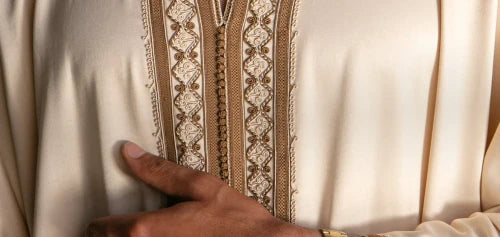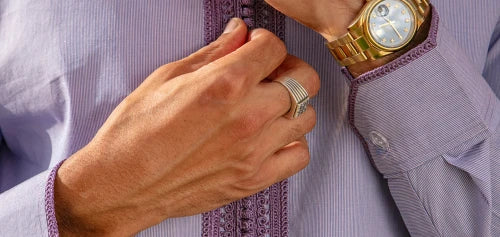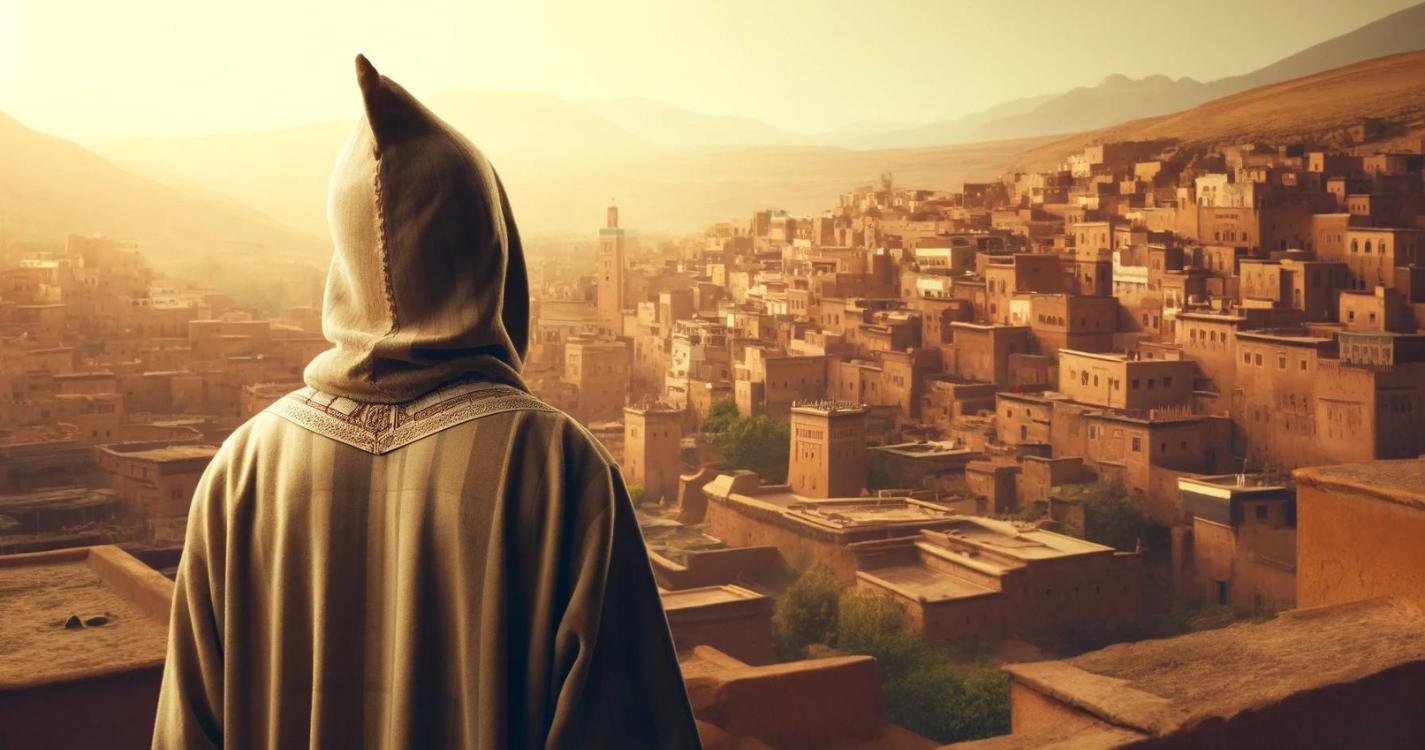Continuing on with our series of Moroccan Cultural Attire Explained, today we will explore the The Moroccan Caftan - A Cultural Treasure!
The Caftan stands as a symbol of elegance, tradition, and cultural heritage. Worn predominantly by women, this exquisite garment holds a special place in Moroccan culture, reflecting a blend of historical influences and artistic craftsmanship. From its origins as ceremonial attire to its modern-day status as a fashion statement, the caftan embodies the essence of Moroccan identity and style. Insha Allah, we will try to uncover the history, styles, and significance of the Moroccan caftan, a garment that continues to captivate hearts and minds around the world.

The History of the Caftan in Morocco
The caftan has a long and storied history in Morocco, dating back centuries to the era of the Islamic Caliphate. It is said that it was likely originated in the Middle East and was introduced to Morocco through trade and cultural exchange. Initially, the caftan was a symbol of status and wealth, worn only by the noble and elite.
Evolution of the Caftan from Ceremonial Dress to Everyday Wear
Over time, the caftan evolved from being purely ceremonial attire to becoming a more practical and versatile garment worn in everyday life. This evolution was influenced by various factors, including changes in fashion trends, socio-cultural shifts, and the need for more functional clothing.
During the Saadian dynasty (16th-17th centuries), the caftan underwent a transformation, becoming more adorned and fancy. It was during this period that the caftan became synonymous with Moroccan fashion and style. The Saadian rulers, known for their love of luxury and refinement, played a key role in popularizing the caftan among the general people. Kind of like the Instagram influencers of today.
Influence of the Saadian Dynasty on the Popularity of the Caftan
The Saadian dynasty was a golden age for Moroccan arts and culture, and the caftan was no exception. Under Saadian rule, the caftan became more than just a garment; it became a symbol of Moroccan identity and pride. The Saadian rulers were known for their extravagant tastes, and this was reflected in the elaborate designs and luxurious fabrics used in caftans of the time.
The Saadian influence extended beyond the royal court, with the general population embracing the caftan as a symbol of their cultural heritage. Today, the legacy of the Saadian dynasty lives on in the vibrant colors, intricate patterns, and exquisite craftsmanship of the Moroccan caftan, ensuring its place as a cherished cultural treasure.
Styles and Variations of the Moroccan Caftan
The traditional Moroccan caftan is characterized by its long, flowing silhouette, which drapes elegantly over the wearer's body. It typically features long sleeves and a high neckline, with the length of the garment varying depending on the occasion and the wearer's preference. The caftan is often cinched at the waist with a large, thick belt or sash, creating a flattering silhouette that accentuates the curves of the body.
Differences Between Moroccan Caftans and Caftans from Other Regions

While caftans are worn in various regions around the world, Moroccan caftans are distinct in their design and craftsmanship. Moroccan caftans are known for their intricate embroidery, elaborate beadwork, and luxurious fabrics, which set them apart from caftans found in other regions. Additionally, Moroccan caftans often feature unique cultural motifs and designs that reflect the country's rich history and heritage.
Styles of Caftans Worn for Different Occasions
In Moroccan culture, caftans are worn for a variety of occasions, each with its own style and design. For brides on their henna party, women often wear satin or silk caftans embellished with intricate embroidery (tarz or tatriz), beadwork, and sequins, and it's all brought together using finishings such as sfifa creating a dazzling effect that is perfect for celebrating the joyous occasion.

For festivals and other special events, caftans may feature bold colors and vibrant patterns, making them a striking choice for festive gatherings. In contrast, for more formal occasions, such as religious ceremonies, nikkah or official functions, caftans may be more understated, with a focus on elegant fabrics and classic designs using delicate techniques such as Randa.
How the Caftan is Worn in Moroccan Culture
In Moroccan culture, the caftan is typically worn as a dress, with the fabric varying depending on the occasion and personal preference. It is often worn alone as a one piece, without any pants or leggings, as it is designed to be a full-length garment that covers the body. The caftan is known for its elegant and modest silhouette, making it a popular choice for formal events and special occasions.
Accessories Often Paired with the Caftan
Accessories play a key role in completing the caftan. One of the most common accessories paired with the caftan is a belt or sash, which is usually created from the fabric of the caftan wrapped over a thick cardboard. The belt is used to cinch the waist and add definition to the silhouette. The thickness and design of the belt can change according to what is trending at the time. Some time ago it was all about being large and thick like the Kimono belt style. However, currently, it's all about thin and simple sashes, delicately decorated, that tie at the back. For the older generation, brides or for more lavash occasions such as weddings, a solid, real gold belt, called 'Mdama', or 'Filali' is worn.

Jewelry is also an important accessory, with women often wearing necklaces, earrings, bracelets, and rings to complement their caftans. Other accessories, such as scarves, shawls, and handbags, are also used to enhance the overall look.
Cultural Significance of Wearing a Caftan for Special Occasions
Wearing a caftan for special occasions holds deep cultural significance in Moroccan society. It is a symbol of elegance, femininity, and cultural pride, reflecting the wearer's appreciation for traditional Moroccan craftsmanship and design. The caftan is often passed down from generation to generation, serving as a tangible link to the past and a celebration of Moroccan heritage. To this day, for many Moroccans, wearing a caftan for special occasions is not just about dressing up; it is a way of honoring their culture, history, and identity.
Modern Adaptations of the Moroccan Caftan
In recent years, the Moroccan caftan has undergone a transformation, with designers creating contemporary styles that appeal to a modern audience. While traditional caftans are still popular for special occasions, contemporary caftans are designed for everyday wear, with a focus on comfort, versatility, and style. Contemporary caftans often feature simpler silhouettes, lighter fabrics, and modern prints and patterns, making them suitable for a wide range of occasions.
Evolution of the Caftan in Modern Moroccan Fashion
The caftan has evolved significantly in modern Moroccan fashion, reflecting changing tastes and trends. While traditional caftans remain popular for formal events, modern caftans are designed to be more accessible and wearable for everyday life. Designers are experimenting with new fabrics, colors, and styles, incorporating elements of Western fashion to create a more contemporary look. The caftan has also become a popular choice among fashion-forward Moroccans who appreciate its timeless elegance and cultural significance.
Influence of Western Fashion on the Design of Modern Caftans
I feel it's important to note that in recent years, Western fashion has had a significant influence on the design of modern caftans, with designers incorporating Western trends and styles into their designs. This fusion of East and West has resulted in caftans that are more modern, stylish, and versatile but at the same time less Islamic and Muslim friendly. Western influences can be seen in the use of new fabrics, such as chiffon and satin, as well as in the addition of modern embellishments, such as sequins and beads.

The disadvantages of this is that many designs are now more revealing, tighter fitted and incorporate see-through fabrics that show the skin. Of course all of this violates the Islamic laws of hijab. And so, while these modernised Caftans are permissible to wear during household celebrations with family, and during women only events, it makes it very inconvenient to go out in for those adhering to the Islamic ruling of dress.
Overall, the influence of Western fashion has helped to modernize the caftan, making it a more relevant and fashionable garment for contemporary Moroccan women wanting to enjoy the best of both worlds.









